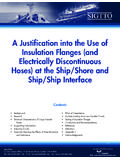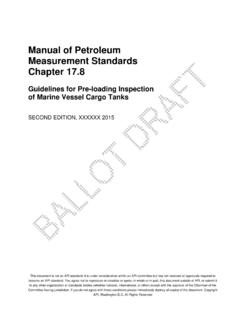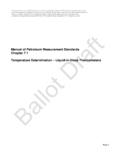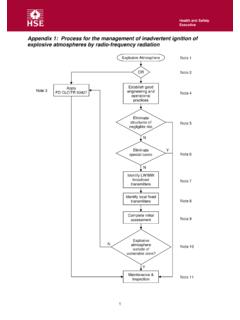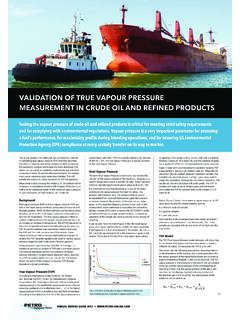Transcription of Introduction to the CD ROM Edition of ISGOTT - …
1 Introduction to the CD ROM Edition of ISGOTT . This Edition is presented in Portable Document Format' and requires the Adobe Acrobat Reader (v3 or later) to present it on screen. That program is a product of Adobe Corporation and a free copy is supplied on the CD ROM, although many computers will already have a copy installed. Please note that this publication cannot be used with earlier versions of Acrobat, eg version 2. For full instruction in how to use the program, please view the documents listed under Acrobat's help menu. If you are not familiar with the program spend a few minutes exploring the facilities offered in the menus and buttons at the top of the screen. You cannot damage or accidentally delete ISGOTT using the Acrobat or indeed any program since the information on the CD ROM is read-only' and cannot be changed.
2 We have tried to make ISGOTT appear almost identically on screen and on paper but note the following differences: although each electronic page' contains the same information as the corresponding printed page, their numbers differ. The CD ROM Edition is numbered sequentially so that it corresponds with the page numbers indicated by the Acrobat program. most computer screens cannot display a page of A4 text at full size but you may use the Acrobat program to resize the displayed image to suit your screen. For further information please refer to the documentation supplied with this Edition and look at the ' file on the CD ROM (eg using the Notepad program supplied with Microsoft Windows ). This contains information not available when the documentation was printed.
3 International Safety Guide for Oil Tankers & Terminals ( ISGOTT ). FOURTH Edition . INTERNATIONAL CHAMBER OF SHIPPING. OIL COMPANIES INTERNATIONAL MARINE FORUM. INTERNATIONAL ASSOCIATION OF PORTS AND HARBORS. The International Chamber of Shipping (ICS) is a voluntary organisation of national shipowners' associations. It was established as long ago as 1921 and represents more than half the world's merchant tonnage. The interests of ICS cover all aspects of maritime affairs, but it is particularly active in the field of marine safety, ship design and construction, pollution prevention and maritime law. ICS has consultative status with several inter-governmental organisations, notably IMO. The Oil Companies International Marine Forum (OCIMF) is a voluntary association of oil companies having an interest in the shipment and terminalling of crude oil and oil products.
4 OCIMF is organised to represent its membership before, and consult with, the International Maritime Organisation (IMO) and other government bodies on matters relating to the shipment and terminalling of crude oil and oil products, including marine pollution and safety. The International Association of Ports and Harbors (IAPH) is a voluntary world-wide association of port authorities, founded in 1955. Current membership includes 230. regular and 154 associate members encompassing 77 countries. IAPH is committed to the exchange and promotion of ideas and technical knowledge on issues of concern to those who work in ports and related industries. Its consultative status with UN and other organisations, including IMO, is a positive benefit in this regard.
5 First Published in 1978 by Witherby & Co. Ltd., 32/36 Aylesbury Street, London, EC1R 0ET, England Tel no: +44 171 251 5341. Fax no: +44 171 251 1296. Reprinted April 1979. Second Edition 1984. Reprinted April 1986. Third Edition 1988. Reprinted March 1990. Third Edition Revised 1991. Fourth Edition 1996. International Chamber of Shipping, London and Oil Companies International Marine Forum, Bermuda 1978, 1979, 1984, 1986, 1988, 1990, 1991, 1996. ISBN 1 85609 081 7. ISGOTT 4. British Library Cataloguing in Publication Data International Chamber of Shipping, Oil Companies International Marine Forum, International Association of Ports and Harbors, International Safety Guide for Oil Tankers and Terminals Fourth Edition I Title ISBN 1 85689 081 7.
6 While the advice given in this document ("document") has been developed using the best information currently available, it is intended purely as guidance to be used at the user's own risk. No responsibility is accepted by the International Chamber of Shipping (ICS), the Oil Companies International Marine Forum (OCIMF), the International Association of Ports and Harbors (IAPH), the membership of ICS, OCIMF, IAPH or by any person, firm, corporation or organisation [who or which has been in way concerned with the furnishing of information or data, the compilation or any translation, publishing supply or sale of the document] for the accuracy of any information or advice given in the document or any omission from the document or for any consequence whatsoever resulting directly or indirectly from compliance with or adoption of guidance contained in the document even if caused by a failure to exercise reasonable care.
7 Printed in England by Witherby & Co. Ltd., 32/36 Aylesbury Street, London, EC1R 0ET. ISGOTT 5. Foreword to Fourth Edition Safety is critical to the well-being and reputation of the tanker industry. The International Safety Guide for Oil Tankers and Terminals, or ISGOTT as it is now widely known, is the standard reference work on the safe operation of oil tankers and the terminals they serve. To remain current, the Guide must keep abreast of changes in vessel design and operating practice and reflect the latest technology. This fourth Edition includes much new guidance on recent developments within the industry. Principal among them is the advent of the double hull tanker as the standard ship. Double hull tankers are not new, but hitherto they have been specialised vessels, generally smaller ships and confined to certain trades.
8 As time passes a growing number of tanker operators will need to familiarise themselves with the special characteristics of double hull vessels. Therefore this new Edition addresses such questions as the possibility of hydrocarbon gas leakage into double hull spaces and the stability of some double hull designs during simultaneous ballast and cargo handling. Account has been taken in this revision of the growing awareness of air pollution and the use of vapour return lines to avoid venting all hydrocarbon vapours to the atmosphere. The potential problems created by over-pressurisation or under-pressurisation of cargo tanks have also been addressed. The opportunity has been taken to improve and update the text in a number of other respects to ensure that ISGOTT continues to provide the best technical guidance on tanker and terminal operations.
9 All operators are urged to ensure that the recommendations in this guide are not only read and fully understood, but also followed. ISGOTT 6. CONTENTS. FOREWORD TO FOURTH Edition 6. PURPOSE AND SCOPE 13. BIBLIOGRAPHY 15. DEFINITIONS 17. PART I: OPERATIONS. CHAPTER 1 HAZARDS OF PETROLEUM 26. Flammability 26. Flammability Classification 26. Gas Density 27. Toxicity 27. CHAPTER 2 GENERAL PRECAUTIONS ON TANKERS 28. General Principles 28. Smoking And Naked Lights 29. Galley 29. Portable Lamps And Electrical Equipment 29. Fixed Electrical Equipment 30. Synthetic Clothing 31. Radio Transmitting Antennae 31. Hot Work 31. Use Of Tools 35. Aluminium 35. Cathodic Protection Anodes In Cargo Tanks 36. Spontaneous Combustion 36.
10 Auto-Ignition 36. Engine And Boiler Rooms 36. Cold Weather Precautions 37. Entry Into Enclosed Spaces 38. Pumprooms 38. CHAPTER 3 ARRIVAL IN PORT 41. Exchange Of Information 41. Preparation For Arrival 43. Entering Or Leaving Port 44. Capacity Of Jetty Fendering 44. Mooring At Jetty Berths 44. Buoy Moorings 46. Emergency Release Procedures 47. ISGOTT 7. CHAPTER 4 GENERAL PRECAUTIONS WHILE A TANKER IS AT A PETROLEUM. BERTH 49. Safety Precautions And Emergency Procedures 49. Management Of Moorings While Alongside 50. Management Of Moorings At Buoy Berths 51. State Of Readiness 51. Communications 51. Access Between Ship And Shore 52. Notices 53. Smoking 53. Galley Stoves And Cooking Appliances 54. Fixed And Portable Electrical Equipment 54.
